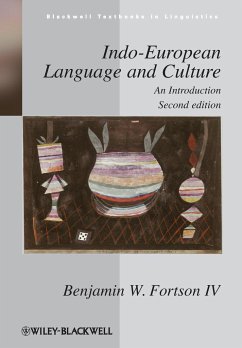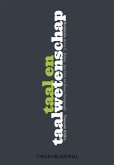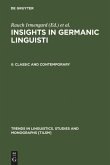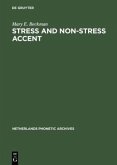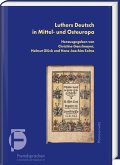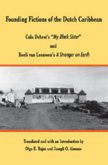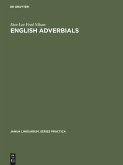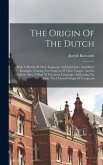- Broschiertes Buch
- Merkliste
- Auf die Merkliste
- Bewerten Bewerten
- Teilen
- Produkt teilen
- Produkterinnerung
- Produkterinnerung
This revised and expanded edition provides a comprehensive overview of comparative Indo-European linguistics and the branches of the Indo-European language family, covering both linguistic and cultural material. Now offering even greater coverage than the first edition, it is the definitive introduction to the field.
Updated, corrected, and expanded edition, containing new illustrations of selected texts and inscriptions, and text samples with translations and etymological commentary
Extensively covers individual histories of both ancient and modern languages of the Indo-European…mehr
Andere Kunden interessierten sich auch für
![Taal En Taalwetenschap Taal En Taalwetenschap]() Taal En Taalwetenschap40,99 €
Taal En Taalwetenschap40,99 €![Classic and Contemporary Classic and Contemporary]() Classic and ContemporaryClassic and Contemporary141,99 €
Classic and ContemporaryClassic and Contemporary141,99 €![Stress and Non-Stress Accent Stress and Non-Stress Accent]() Mary E. BeckmanStress and Non-Stress Accent81,99 €
Mary E. BeckmanStress and Non-Stress Accent81,99 €![Luthers Deutsch in Mittel- und Osteuropa Luthers Deutsch in Mittel- und Osteuropa]() Luthers Deutsch in Mittel- und Osteuropa68,00 €
Luthers Deutsch in Mittel- und Osteuropa68,00 €![Founding Fictions of the Dutch Caribbean Founding Fictions of the Dutch Caribbean]() Olga E. RojerFounding Fictions of the Dutch Caribbean43,60 €
Olga E. RojerFounding Fictions of the Dutch Caribbean43,60 €![English Adverbials English Adverbials]() Don Lee Fred NilsenEnglish Adverbials82,99 €
Don Lee Fred NilsenEnglish Adverbials82,99 €![The Origin Of The Dutch: With A Sketch Of Their Language And Literature, And Short Examples, Tracing The Progress Of Their Tongue, And Its Dial The Origin Of The Dutch: With A Sketch Of Their Language And Literature, And Short Examples, Tracing The Progress Of Their Tongue, And Its Dial]() Joseph BosworthThe Origin Of The Dutch: With A Sketch Of Their Language And Literature, And Short Examples, Tracing The Progress Of Their Tongue, And Its Dial33,99 €
Joseph BosworthThe Origin Of The Dutch: With A Sketch Of Their Language And Literature, And Short Examples, Tracing The Progress Of Their Tongue, And Its Dial33,99 €-
-
-
This revised and expanded edition provides a comprehensive overview of comparative Indo-European linguistics and the branches of the Indo-European language family, covering both linguistic and cultural material. Now offering even greater coverage than the first edition, it is the definitive introduction to the field.
Updated, corrected, and expanded edition, containing new illustrations of selected texts and inscriptions, and text samples with translations and etymological commentary
Extensively covers individual histories of both ancient and modern languages of the Indo-European family
Provides an overview of Proto-Indo-European culture, society, and language
Designed for use in courses, with exercises and suggestions for further reading included in each chapter
Includes maps, a glossary, a bibliography, and comprehensive word and subject indexes
Hinweis: Dieser Artikel kann nur an eine deutsche Lieferadresse ausgeliefert werden.
Updated, corrected, and expanded edition, containing new illustrations of selected texts and inscriptions, and text samples with translations and etymological commentary
Extensively covers individual histories of both ancient and modern languages of the Indo-European family
Provides an overview of Proto-Indo-European culture, society, and language
Designed for use in courses, with exercises and suggestions for further reading included in each chapter
Includes maps, a glossary, a bibliography, and comprehensive word and subject indexes
Hinweis: Dieser Artikel kann nur an eine deutsche Lieferadresse ausgeliefert werden.
Produktdetails
- Produktdetails
- Blackwell Textbooks in Linguistics
- Verlag: Wiley & Sons
- 2nd ed.
- Seitenzahl: 576
- Erscheinungstermin: 29. Juli 2009
- Englisch
- Abmessung: 244mm x 170mm x 31mm
- Gewicht: 843g
- ISBN-13: 9781405188968
- ISBN-10: 1405188960
- Artikelnr.: 26499852
- Herstellerkennzeichnung
- Libri GmbH
- Europaallee 1
- 36244 Bad Hersfeld
- gpsr@libri.de
- Blackwell Textbooks in Linguistics
- Verlag: Wiley & Sons
- 2nd ed.
- Seitenzahl: 576
- Erscheinungstermin: 29. Juli 2009
- Englisch
- Abmessung: 244mm x 170mm x 31mm
- Gewicht: 843g
- ISBN-13: 9781405188968
- ISBN-10: 1405188960
- Artikelnr.: 26499852
- Herstellerkennzeichnung
- Libri GmbH
- Europaallee 1
- 36244 Bad Hersfeld
- gpsr@libri.de
Benjamin W. Fortson IV is Associate Professor of Greek and Latin Language, Literature, and Historical Linguistics in the Department of Classical Studies at the University of Michigan.
List of Illustrations xi
Preface xii
Preface to the Second Edition xvi
Acknowledgments xvii
Guide to the Reader xix
1 Introduction: The Comparative Method and the Indo-European Family 1
The Study of Language Relationships and the Comparative Method (§§1.1-12) 1
Indo-European Historical Linguistics (§§1.13-19) 8
Conclusion (§§1.20-22) 14
For Further Reading 15
For Review 16
Exercises 16
2 Proto-Indo-European Culture and Archaeology 18
Introduction (§§2.1-2) 18
Society (§§2.3-16) 19
Religion, Ritual, and Myth (§§2.17-36) 25
Poetics (§§2.37-45) 32
Personal Names (§§2.46-49) 38
Archaeology and the PIE Homeland Question (§§2.50-73) 39
For Further Reading 49
For Review 50
Exercises 50
3 Proto-Indo-European Phonology 53
Introduction (§3.1) 53
Consonants (§§3.2-25) 53
Vowels (§§3.26-32) 66
Phonological Rules (§§3.33-44) 69
For Further Reading 72
For Review 73
Exercises 73
4 Proto-Indo-European Morphology: Introduction 75
The Root and Indo-European Morphophonemics (§4.1) 75
The Root (§§4.2-11) 76
Ablaut (§§4.12-19) 79
Morphological Categories of PIE (§§4.20-24) 83
For Further Reading 85
For Review 85
Exercises 85
5 The Verb 88
The Structure of the PIE Verb (§§5.1-10) 88
Personal Endings (§§5.11-18) 91
The Present Stem (§§5.19-44) 95
The Aorist Stem (§§5.45-50) 101
The Perfect Stem (§§5.51-53) 103
Moods (§§5.54-57) 105
Non-finite Verbal Formations and Other Topics (§§5.58-63) 107
For Further Reading 110
For Review 110
Exercises 110
6 The Noun 113
Introduction (§§6.1-3) 113
Athematic Nouns (§§6.4-42) 114
Thematic Nouns (§§6.43-67) 126
The Collective and the Feminine (§§6.68-71) 131
Adjectives (§§6.72-81) 134
Nominal Composition and Other Topics (§§6.82-87) 136
For Further Reading 137
For Review 138
Exercises 138
7 Pronouns and Other Parts of Speech 140
Pronouns: Introduction (§7.1) 140
Personal Pronouns (§§7.2-8) 140
Other Pronouns and the Pronominal Declension (§§7.9-14) 143
Numerals (§§7.15-22) 145
Adverbs (§§7.23-25) 147
Prepositions and Postpositions (§7.26) 148
Conjunctions and Interjections (§§7.27-30) 149
For Further Reading 150
Exercises 151
8 Proto-Indo-European Syntax 152
Introduction (§§8.1-5) 152
Syntax of the Phrase (§§8.6-11) 154
Syntax of the Clause (§§8.12-30) 156
Phrase and Sentence Prosody and the Interaction of Syntax and Phonology
(§§8.31-36) 165
For Further Reading 168
For Review 168
Exercises 169
9 Anatolian 170
Introduction (§§9.1-4) 170
From PIE to Common Anatolian (§§9.5-14) 172
Hittite (§§9.15-44) 174
Luvian (§§9.45-58) 185
Palaic (§§9.59-61) 192
Lycian (§§9.62-70) 193
Lydian (§§9.71-75) 195
Carian, Pisidian, and Sidetic (§9.76) 198
For Further Reading 198
For Review 199
Exercises 199
PIE Vocabulary I: Man, Woman, Kinship 200
10 Indo-Iranian I: Indic 202
Introduction to Indo-Iranian (§§10.1-4) 202
From PIE to Indo-Iranian (§§10.5-19) 203
Indic (Indo-Aryan) (§§10.20-22) 206
Sanskrit (§§10.23-51) 207
Middle Indic (§§10.52-57) 219
Modern (New) Indo-Aryan (§§10.58-63) 221
For Further Reading 223
For Review 224
Exercises 224
PIE Vocabulary II: Animals 226
11 Indo-Iranian II: Iranian 227
Introduction (§§11.1-8) 227
Avestan (§§11.9-27) 228
Old Persian (§§11.28-36) 236
Middle and Modern Iranian (§§11.37-53) 241
For Further Reading 245
For Review 245
Exercises 246
PIE Vocabulary III: Food and Agriculture 247
12 Greek 248
Introduction (§§12.1-8) 248
From PIE to Greek (§§12.9-53) 252
Greek after the Classical Period (§§12.54-57) 263
The Philology of Homer and Its Pitfalls (§§12.58-67) 264
For Further Reading 270
For Review 271
Exercises 271
PIE Vocabulary IV: The Body 273
13 Italic 274
Introduction (§§13.1-5) 274
From PIE to Italic (§§13.6-23) 277
Latino-Faliscan (§13.24) 281
Latin (§§13.25-53) 282
Faliscan (§§13.54-55) 294
Sabellic (Osco-Umbrian) (§§13.56-66) 296
Umbrian (§§13.67-74) 298
South Picene (§§13.75-76) 300
Oscan (§§13.77-80) 302
Other Sabellic Languages (§13.81) 303
For Further Reading 304
For Review 304
Exercises 305
PIE Vocabulary V: Body Functions and States 307
14 Celtic 309
Introduction (§§14.1-3) 309
From PIE to Celtic (§§14.4-11) 310
Continental Celtic (§§14.12-19) 312
Insular Celtic (§§14.20-27) 316
Goidelic: Old Irish and Its Descendants (§§14.28-50) 319
Scottish Gaelic and Manx (§§14.51-52) 327
Brittonic (§§14.53-56) 328
Welsh (§§14.57-61) 329
Breton (§§14.62-68) 331
Cornish (§§14.69-72) 334
For Further Reading 335
For Review 335
Exercises 335
PIE Vocabulary VI: Natural Environment 337
15 Germanic 338
Introduction (§§15.1-4) 338
From PIE to Germanic (§§15.5-35) 339
Runic (§§15.36-39) 348
East Germanic (§15.40) 350
Gothic (§§15.41-48) 353
West Germanic (§§15.49-51) 356
Old English (§§15.52-64) 357
Middle and Modern English (§§15.65-69) 362
Old High German (§§15.70-81) 365
Old Saxon (§§15.82-85) 370
Dutch and Frisian (§§15.86-88) 371
North Germanic: Old Norse and Scandinavian (§§15.89-108) 372
For Further Reading 378
For Review 379
Exercises 379
PIE Vocabulary VII: Position and Motion 381
16 Armenian 382
Introduction (§§16.1-10) 382
From PIE to Classical Armenian (§§16.11-41) 385
Middle and Modern Armenian (§§16.42-47) 393
For Further Reading 397
For Review 397
Exercises 397
PIE Vocabulary VIII: Material Culture and Technology 399
17 Tocharian 400
Introduction (§§17.1-6) 400
From PIE to Tocharian (§§17.7-33) 402
For Further Reading 412
For Review 412
Exercises 412
PIE Vocabulary IX: Form and Size 413
18 Balto-Slavic 414
Introduction (§18.1) 414
From PIE to Balto-Slavic (§§18.2-18) 415
Slavic (§§18.19-39) 419
Old Church Slavonic (§§18.40-42) 426
Modern Slavic Languages (§§18.43-55) 428
Baltic (§§18.56-67) 432
Lithuanian (§§18.68-74) 435
Latvian (§§18.75-76) 439
Old Prussian (§§18.77-79) 440
For Further Reading 442
For Review 443
Exercises 443
PIE Vocabulary X: Time 445
19 Albanian 446
Introduction (§§19.1-5) 446
From PIE to Albanian (§§19.6-29) 448
For Further Reading 456
Exercises 457
PIE Vocabulary XI: Utterance 458
20 Fragmentary Languages 459
Introduction (§§20.1-2) 459
Phrygian (§§20.3-9) 460
Thracian (§§20.10-11) 463
Macedonian (§20.12) 464
Illyrian (§§20.13-15) 464
Venetic (§§20.16-20) 465
Messapic (§§20.21-22) 467
Sicel and Elymian (§20.23) 469
Lusitanian (§20.24) 469
For Further Reading 469
Exercises 470
PIE Vocabulary XII: Basic Physical Acts 471
Glossary 472
Bibliography 477
Subject Index 490
Word Index 510
Preface xii
Preface to the Second Edition xvi
Acknowledgments xvii
Guide to the Reader xix
1 Introduction: The Comparative Method and the Indo-European Family 1
The Study of Language Relationships and the Comparative Method (§§1.1-12) 1
Indo-European Historical Linguistics (§§1.13-19) 8
Conclusion (§§1.20-22) 14
For Further Reading 15
For Review 16
Exercises 16
2 Proto-Indo-European Culture and Archaeology 18
Introduction (§§2.1-2) 18
Society (§§2.3-16) 19
Religion, Ritual, and Myth (§§2.17-36) 25
Poetics (§§2.37-45) 32
Personal Names (§§2.46-49) 38
Archaeology and the PIE Homeland Question (§§2.50-73) 39
For Further Reading 49
For Review 50
Exercises 50
3 Proto-Indo-European Phonology 53
Introduction (§3.1) 53
Consonants (§§3.2-25) 53
Vowels (§§3.26-32) 66
Phonological Rules (§§3.33-44) 69
For Further Reading 72
For Review 73
Exercises 73
4 Proto-Indo-European Morphology: Introduction 75
The Root and Indo-European Morphophonemics (§4.1) 75
The Root (§§4.2-11) 76
Ablaut (§§4.12-19) 79
Morphological Categories of PIE (§§4.20-24) 83
For Further Reading 85
For Review 85
Exercises 85
5 The Verb 88
The Structure of the PIE Verb (§§5.1-10) 88
Personal Endings (§§5.11-18) 91
The Present Stem (§§5.19-44) 95
The Aorist Stem (§§5.45-50) 101
The Perfect Stem (§§5.51-53) 103
Moods (§§5.54-57) 105
Non-finite Verbal Formations and Other Topics (§§5.58-63) 107
For Further Reading 110
For Review 110
Exercises 110
6 The Noun 113
Introduction (§§6.1-3) 113
Athematic Nouns (§§6.4-42) 114
Thematic Nouns (§§6.43-67) 126
The Collective and the Feminine (§§6.68-71) 131
Adjectives (§§6.72-81) 134
Nominal Composition and Other Topics (§§6.82-87) 136
For Further Reading 137
For Review 138
Exercises 138
7 Pronouns and Other Parts of Speech 140
Pronouns: Introduction (§7.1) 140
Personal Pronouns (§§7.2-8) 140
Other Pronouns and the Pronominal Declension (§§7.9-14) 143
Numerals (§§7.15-22) 145
Adverbs (§§7.23-25) 147
Prepositions and Postpositions (§7.26) 148
Conjunctions and Interjections (§§7.27-30) 149
For Further Reading 150
Exercises 151
8 Proto-Indo-European Syntax 152
Introduction (§§8.1-5) 152
Syntax of the Phrase (§§8.6-11) 154
Syntax of the Clause (§§8.12-30) 156
Phrase and Sentence Prosody and the Interaction of Syntax and Phonology
(§§8.31-36) 165
For Further Reading 168
For Review 168
Exercises 169
9 Anatolian 170
Introduction (§§9.1-4) 170
From PIE to Common Anatolian (§§9.5-14) 172
Hittite (§§9.15-44) 174
Luvian (§§9.45-58) 185
Palaic (§§9.59-61) 192
Lycian (§§9.62-70) 193
Lydian (§§9.71-75) 195
Carian, Pisidian, and Sidetic (§9.76) 198
For Further Reading 198
For Review 199
Exercises 199
PIE Vocabulary I: Man, Woman, Kinship 200
10 Indo-Iranian I: Indic 202
Introduction to Indo-Iranian (§§10.1-4) 202
From PIE to Indo-Iranian (§§10.5-19) 203
Indic (Indo-Aryan) (§§10.20-22) 206
Sanskrit (§§10.23-51) 207
Middle Indic (§§10.52-57) 219
Modern (New) Indo-Aryan (§§10.58-63) 221
For Further Reading 223
For Review 224
Exercises 224
PIE Vocabulary II: Animals 226
11 Indo-Iranian II: Iranian 227
Introduction (§§11.1-8) 227
Avestan (§§11.9-27) 228
Old Persian (§§11.28-36) 236
Middle and Modern Iranian (§§11.37-53) 241
For Further Reading 245
For Review 245
Exercises 246
PIE Vocabulary III: Food and Agriculture 247
12 Greek 248
Introduction (§§12.1-8) 248
From PIE to Greek (§§12.9-53) 252
Greek after the Classical Period (§§12.54-57) 263
The Philology of Homer and Its Pitfalls (§§12.58-67) 264
For Further Reading 270
For Review 271
Exercises 271
PIE Vocabulary IV: The Body 273
13 Italic 274
Introduction (§§13.1-5) 274
From PIE to Italic (§§13.6-23) 277
Latino-Faliscan (§13.24) 281
Latin (§§13.25-53) 282
Faliscan (§§13.54-55) 294
Sabellic (Osco-Umbrian) (§§13.56-66) 296
Umbrian (§§13.67-74) 298
South Picene (§§13.75-76) 300
Oscan (§§13.77-80) 302
Other Sabellic Languages (§13.81) 303
For Further Reading 304
For Review 304
Exercises 305
PIE Vocabulary V: Body Functions and States 307
14 Celtic 309
Introduction (§§14.1-3) 309
From PIE to Celtic (§§14.4-11) 310
Continental Celtic (§§14.12-19) 312
Insular Celtic (§§14.20-27) 316
Goidelic: Old Irish and Its Descendants (§§14.28-50) 319
Scottish Gaelic and Manx (§§14.51-52) 327
Brittonic (§§14.53-56) 328
Welsh (§§14.57-61) 329
Breton (§§14.62-68) 331
Cornish (§§14.69-72) 334
For Further Reading 335
For Review 335
Exercises 335
PIE Vocabulary VI: Natural Environment 337
15 Germanic 338
Introduction (§§15.1-4) 338
From PIE to Germanic (§§15.5-35) 339
Runic (§§15.36-39) 348
East Germanic (§15.40) 350
Gothic (§§15.41-48) 353
West Germanic (§§15.49-51) 356
Old English (§§15.52-64) 357
Middle and Modern English (§§15.65-69) 362
Old High German (§§15.70-81) 365
Old Saxon (§§15.82-85) 370
Dutch and Frisian (§§15.86-88) 371
North Germanic: Old Norse and Scandinavian (§§15.89-108) 372
For Further Reading 378
For Review 379
Exercises 379
PIE Vocabulary VII: Position and Motion 381
16 Armenian 382
Introduction (§§16.1-10) 382
From PIE to Classical Armenian (§§16.11-41) 385
Middle and Modern Armenian (§§16.42-47) 393
For Further Reading 397
For Review 397
Exercises 397
PIE Vocabulary VIII: Material Culture and Technology 399
17 Tocharian 400
Introduction (§§17.1-6) 400
From PIE to Tocharian (§§17.7-33) 402
For Further Reading 412
For Review 412
Exercises 412
PIE Vocabulary IX: Form and Size 413
18 Balto-Slavic 414
Introduction (§18.1) 414
From PIE to Balto-Slavic (§§18.2-18) 415
Slavic (§§18.19-39) 419
Old Church Slavonic (§§18.40-42) 426
Modern Slavic Languages (§§18.43-55) 428
Baltic (§§18.56-67) 432
Lithuanian (§§18.68-74) 435
Latvian (§§18.75-76) 439
Old Prussian (§§18.77-79) 440
For Further Reading 442
For Review 443
Exercises 443
PIE Vocabulary X: Time 445
19 Albanian 446
Introduction (§§19.1-5) 446
From PIE to Albanian (§§19.6-29) 448
For Further Reading 456
Exercises 457
PIE Vocabulary XI: Utterance 458
20 Fragmentary Languages 459
Introduction (§§20.1-2) 459
Phrygian (§§20.3-9) 460
Thracian (§§20.10-11) 463
Macedonian (§20.12) 464
Illyrian (§§20.13-15) 464
Venetic (§§20.16-20) 465
Messapic (§§20.21-22) 467
Sicel and Elymian (§20.23) 469
Lusitanian (§20.24) 469
For Further Reading 469
Exercises 470
PIE Vocabulary XII: Basic Physical Acts 471
Glossary 472
Bibliography 477
Subject Index 490
Word Index 510
List of Illustrations xi
Preface xii
Preface to the Second Edition xvi
Acknowledgments xvii
Guide to the Reader xix
1 Introduction: The Comparative Method and the Indo-European Family 1
The Study of Language Relationships and the Comparative Method (§§1.1-12) 1
Indo-European Historical Linguistics (§§1.13-19) 8
Conclusion (§§1.20-22) 14
For Further Reading 15
For Review 16
Exercises 16
2 Proto-Indo-European Culture and Archaeology 18
Introduction (§§2.1-2) 18
Society (§§2.3-16) 19
Religion, Ritual, and Myth (§§2.17-36) 25
Poetics (§§2.37-45) 32
Personal Names (§§2.46-49) 38
Archaeology and the PIE Homeland Question (§§2.50-73) 39
For Further Reading 49
For Review 50
Exercises 50
3 Proto-Indo-European Phonology 53
Introduction (§3.1) 53
Consonants (§§3.2-25) 53
Vowels (§§3.26-32) 66
Phonological Rules (§§3.33-44) 69
For Further Reading 72
For Review 73
Exercises 73
4 Proto-Indo-European Morphology: Introduction 75
The Root and Indo-European Morphophonemics (§4.1) 75
The Root (§§4.2-11) 76
Ablaut (§§4.12-19) 79
Morphological Categories of PIE (§§4.20-24) 83
For Further Reading 85
For Review 85
Exercises 85
5 The Verb 88
The Structure of the PIE Verb (§§5.1-10) 88
Personal Endings (§§5.11-18) 91
The Present Stem (§§5.19-44) 95
The Aorist Stem (§§5.45-50) 101
The Perfect Stem (§§5.51-53) 103
Moods (§§5.54-57) 105
Non-finite Verbal Formations and Other Topics (§§5.58-63) 107
For Further Reading 110
For Review 110
Exercises 110
6 The Noun 113
Introduction (§§6.1-3) 113
Athematic Nouns (§§6.4-42) 114
Thematic Nouns (§§6.43-67) 126
The Collective and the Feminine (§§6.68-71) 131
Adjectives (§§6.72-81) 134
Nominal Composition and Other Topics (§§6.82-87) 136
For Further Reading 137
For Review 138
Exercises 138
7 Pronouns and Other Parts of Speech 140
Pronouns: Introduction (§7.1) 140
Personal Pronouns (§§7.2-8) 140
Other Pronouns and the Pronominal Declension (§§7.9-14) 143
Numerals (§§7.15-22) 145
Adverbs (§§7.23-25) 147
Prepositions and Postpositions (§7.26) 148
Conjunctions and Interjections (§§7.27-30) 149
For Further Reading 150
Exercises 151
8 Proto-Indo-European Syntax 152
Introduction (§§8.1-5) 152
Syntax of the Phrase (§§8.6-11) 154
Syntax of the Clause (§§8.12-30) 156
Phrase and Sentence Prosody and the Interaction of Syntax and Phonology
(§§8.31-36) 165
For Further Reading 168
For Review 168
Exercises 169
9 Anatolian 170
Introduction (§§9.1-4) 170
From PIE to Common Anatolian (§§9.5-14) 172
Hittite (§§9.15-44) 174
Luvian (§§9.45-58) 185
Palaic (§§9.59-61) 192
Lycian (§§9.62-70) 193
Lydian (§§9.71-75) 195
Carian, Pisidian, and Sidetic (§9.76) 198
For Further Reading 198
For Review 199
Exercises 199
PIE Vocabulary I: Man, Woman, Kinship 200
10 Indo-Iranian I: Indic 202
Introduction to Indo-Iranian (§§10.1-4) 202
From PIE to Indo-Iranian (§§10.5-19) 203
Indic (Indo-Aryan) (§§10.20-22) 206
Sanskrit (§§10.23-51) 207
Middle Indic (§§10.52-57) 219
Modern (New) Indo-Aryan (§§10.58-63) 221
For Further Reading 223
For Review 224
Exercises 224
PIE Vocabulary II: Animals 226
11 Indo-Iranian II: Iranian 227
Introduction (§§11.1-8) 227
Avestan (§§11.9-27) 228
Old Persian (§§11.28-36) 236
Middle and Modern Iranian (§§11.37-53) 241
For Further Reading 245
For Review 245
Exercises 246
PIE Vocabulary III: Food and Agriculture 247
12 Greek 248
Introduction (§§12.1-8) 248
From PIE to Greek (§§12.9-53) 252
Greek after the Classical Period (§§12.54-57) 263
The Philology of Homer and Its Pitfalls (§§12.58-67) 264
For Further Reading 270
For Review 271
Exercises 271
PIE Vocabulary IV: The Body 273
13 Italic 274
Introduction (§§13.1-5) 274
From PIE to Italic (§§13.6-23) 277
Latino-Faliscan (§13.24) 281
Latin (§§13.25-53) 282
Faliscan (§§13.54-55) 294
Sabellic (Osco-Umbrian) (§§13.56-66) 296
Umbrian (§§13.67-74) 298
South Picene (§§13.75-76) 300
Oscan (§§13.77-80) 302
Other Sabellic Languages (§13.81) 303
For Further Reading 304
For Review 304
Exercises 305
PIE Vocabulary V: Body Functions and States 307
14 Celtic 309
Introduction (§§14.1-3) 309
From PIE to Celtic (§§14.4-11) 310
Continental Celtic (§§14.12-19) 312
Insular Celtic (§§14.20-27) 316
Goidelic: Old Irish and Its Descendants (§§14.28-50) 319
Scottish Gaelic and Manx (§§14.51-52) 327
Brittonic (§§14.53-56) 328
Welsh (§§14.57-61) 329
Breton (§§14.62-68) 331
Cornish (§§14.69-72) 334
For Further Reading 335
For Review 335
Exercises 335
PIE Vocabulary VI: Natural Environment 337
15 Germanic 338
Introduction (§§15.1-4) 338
From PIE to Germanic (§§15.5-35) 339
Runic (§§15.36-39) 348
East Germanic (§15.40) 350
Gothic (§§15.41-48) 353
West Germanic (§§15.49-51) 356
Old English (§§15.52-64) 357
Middle and Modern English (§§15.65-69) 362
Old High German (§§15.70-81) 365
Old Saxon (§§15.82-85) 370
Dutch and Frisian (§§15.86-88) 371
North Germanic: Old Norse and Scandinavian (§§15.89-108) 372
For Further Reading 378
For Review 379
Exercises 379
PIE Vocabulary VII: Position and Motion 381
16 Armenian 382
Introduction (§§16.1-10) 382
From PIE to Classical Armenian (§§16.11-41) 385
Middle and Modern Armenian (§§16.42-47) 393
For Further Reading 397
For Review 397
Exercises 397
PIE Vocabulary VIII: Material Culture and Technology 399
17 Tocharian 400
Introduction (§§17.1-6) 400
From PIE to Tocharian (§§17.7-33) 402
For Further Reading 412
For Review 412
Exercises 412
PIE Vocabulary IX: Form and Size 413
18 Balto-Slavic 414
Introduction (§18.1) 414
From PIE to Balto-Slavic (§§18.2-18) 415
Slavic (§§18.19-39) 419
Old Church Slavonic (§§18.40-42) 426
Modern Slavic Languages (§§18.43-55) 428
Baltic (§§18.56-67) 432
Lithuanian (§§18.68-74) 435
Latvian (§§18.75-76) 439
Old Prussian (§§18.77-79) 440
For Further Reading 442
For Review 443
Exercises 443
PIE Vocabulary X: Time 445
19 Albanian 446
Introduction (§§19.1-5) 446
From PIE to Albanian (§§19.6-29) 448
For Further Reading 456
Exercises 457
PIE Vocabulary XI: Utterance 458
20 Fragmentary Languages 459
Introduction (§§20.1-2) 459
Phrygian (§§20.3-9) 460
Thracian (§§20.10-11) 463
Macedonian (§20.12) 464
Illyrian (§§20.13-15) 464
Venetic (§§20.16-20) 465
Messapic (§§20.21-22) 467
Sicel and Elymian (§20.23) 469
Lusitanian (§20.24) 469
For Further Reading 469
Exercises 470
PIE Vocabulary XII: Basic Physical Acts 471
Glossary 472
Bibliography 477
Subject Index 490
Word Index 510
Preface xii
Preface to the Second Edition xvi
Acknowledgments xvii
Guide to the Reader xix
1 Introduction: The Comparative Method and the Indo-European Family 1
The Study of Language Relationships and the Comparative Method (§§1.1-12) 1
Indo-European Historical Linguistics (§§1.13-19) 8
Conclusion (§§1.20-22) 14
For Further Reading 15
For Review 16
Exercises 16
2 Proto-Indo-European Culture and Archaeology 18
Introduction (§§2.1-2) 18
Society (§§2.3-16) 19
Religion, Ritual, and Myth (§§2.17-36) 25
Poetics (§§2.37-45) 32
Personal Names (§§2.46-49) 38
Archaeology and the PIE Homeland Question (§§2.50-73) 39
For Further Reading 49
For Review 50
Exercises 50
3 Proto-Indo-European Phonology 53
Introduction (§3.1) 53
Consonants (§§3.2-25) 53
Vowels (§§3.26-32) 66
Phonological Rules (§§3.33-44) 69
For Further Reading 72
For Review 73
Exercises 73
4 Proto-Indo-European Morphology: Introduction 75
The Root and Indo-European Morphophonemics (§4.1) 75
The Root (§§4.2-11) 76
Ablaut (§§4.12-19) 79
Morphological Categories of PIE (§§4.20-24) 83
For Further Reading 85
For Review 85
Exercises 85
5 The Verb 88
The Structure of the PIE Verb (§§5.1-10) 88
Personal Endings (§§5.11-18) 91
The Present Stem (§§5.19-44) 95
The Aorist Stem (§§5.45-50) 101
The Perfect Stem (§§5.51-53) 103
Moods (§§5.54-57) 105
Non-finite Verbal Formations and Other Topics (§§5.58-63) 107
For Further Reading 110
For Review 110
Exercises 110
6 The Noun 113
Introduction (§§6.1-3) 113
Athematic Nouns (§§6.4-42) 114
Thematic Nouns (§§6.43-67) 126
The Collective and the Feminine (§§6.68-71) 131
Adjectives (§§6.72-81) 134
Nominal Composition and Other Topics (§§6.82-87) 136
For Further Reading 137
For Review 138
Exercises 138
7 Pronouns and Other Parts of Speech 140
Pronouns: Introduction (§7.1) 140
Personal Pronouns (§§7.2-8) 140
Other Pronouns and the Pronominal Declension (§§7.9-14) 143
Numerals (§§7.15-22) 145
Adverbs (§§7.23-25) 147
Prepositions and Postpositions (§7.26) 148
Conjunctions and Interjections (§§7.27-30) 149
For Further Reading 150
Exercises 151
8 Proto-Indo-European Syntax 152
Introduction (§§8.1-5) 152
Syntax of the Phrase (§§8.6-11) 154
Syntax of the Clause (§§8.12-30) 156
Phrase and Sentence Prosody and the Interaction of Syntax and Phonology
(§§8.31-36) 165
For Further Reading 168
For Review 168
Exercises 169
9 Anatolian 170
Introduction (§§9.1-4) 170
From PIE to Common Anatolian (§§9.5-14) 172
Hittite (§§9.15-44) 174
Luvian (§§9.45-58) 185
Palaic (§§9.59-61) 192
Lycian (§§9.62-70) 193
Lydian (§§9.71-75) 195
Carian, Pisidian, and Sidetic (§9.76) 198
For Further Reading 198
For Review 199
Exercises 199
PIE Vocabulary I: Man, Woman, Kinship 200
10 Indo-Iranian I: Indic 202
Introduction to Indo-Iranian (§§10.1-4) 202
From PIE to Indo-Iranian (§§10.5-19) 203
Indic (Indo-Aryan) (§§10.20-22) 206
Sanskrit (§§10.23-51) 207
Middle Indic (§§10.52-57) 219
Modern (New) Indo-Aryan (§§10.58-63) 221
For Further Reading 223
For Review 224
Exercises 224
PIE Vocabulary II: Animals 226
11 Indo-Iranian II: Iranian 227
Introduction (§§11.1-8) 227
Avestan (§§11.9-27) 228
Old Persian (§§11.28-36) 236
Middle and Modern Iranian (§§11.37-53) 241
For Further Reading 245
For Review 245
Exercises 246
PIE Vocabulary III: Food and Agriculture 247
12 Greek 248
Introduction (§§12.1-8) 248
From PIE to Greek (§§12.9-53) 252
Greek after the Classical Period (§§12.54-57) 263
The Philology of Homer and Its Pitfalls (§§12.58-67) 264
For Further Reading 270
For Review 271
Exercises 271
PIE Vocabulary IV: The Body 273
13 Italic 274
Introduction (§§13.1-5) 274
From PIE to Italic (§§13.6-23) 277
Latino-Faliscan (§13.24) 281
Latin (§§13.25-53) 282
Faliscan (§§13.54-55) 294
Sabellic (Osco-Umbrian) (§§13.56-66) 296
Umbrian (§§13.67-74) 298
South Picene (§§13.75-76) 300
Oscan (§§13.77-80) 302
Other Sabellic Languages (§13.81) 303
For Further Reading 304
For Review 304
Exercises 305
PIE Vocabulary V: Body Functions and States 307
14 Celtic 309
Introduction (§§14.1-3) 309
From PIE to Celtic (§§14.4-11) 310
Continental Celtic (§§14.12-19) 312
Insular Celtic (§§14.20-27) 316
Goidelic: Old Irish and Its Descendants (§§14.28-50) 319
Scottish Gaelic and Manx (§§14.51-52) 327
Brittonic (§§14.53-56) 328
Welsh (§§14.57-61) 329
Breton (§§14.62-68) 331
Cornish (§§14.69-72) 334
For Further Reading 335
For Review 335
Exercises 335
PIE Vocabulary VI: Natural Environment 337
15 Germanic 338
Introduction (§§15.1-4) 338
From PIE to Germanic (§§15.5-35) 339
Runic (§§15.36-39) 348
East Germanic (§15.40) 350
Gothic (§§15.41-48) 353
West Germanic (§§15.49-51) 356
Old English (§§15.52-64) 357
Middle and Modern English (§§15.65-69) 362
Old High German (§§15.70-81) 365
Old Saxon (§§15.82-85) 370
Dutch and Frisian (§§15.86-88) 371
North Germanic: Old Norse and Scandinavian (§§15.89-108) 372
For Further Reading 378
For Review 379
Exercises 379
PIE Vocabulary VII: Position and Motion 381
16 Armenian 382
Introduction (§§16.1-10) 382
From PIE to Classical Armenian (§§16.11-41) 385
Middle and Modern Armenian (§§16.42-47) 393
For Further Reading 397
For Review 397
Exercises 397
PIE Vocabulary VIII: Material Culture and Technology 399
17 Tocharian 400
Introduction (§§17.1-6) 400
From PIE to Tocharian (§§17.7-33) 402
For Further Reading 412
For Review 412
Exercises 412
PIE Vocabulary IX: Form and Size 413
18 Balto-Slavic 414
Introduction (§18.1) 414
From PIE to Balto-Slavic (§§18.2-18) 415
Slavic (§§18.19-39) 419
Old Church Slavonic (§§18.40-42) 426
Modern Slavic Languages (§§18.43-55) 428
Baltic (§§18.56-67) 432
Lithuanian (§§18.68-74) 435
Latvian (§§18.75-76) 439
Old Prussian (§§18.77-79) 440
For Further Reading 442
For Review 443
Exercises 443
PIE Vocabulary X: Time 445
19 Albanian 446
Introduction (§§19.1-5) 446
From PIE to Albanian (§§19.6-29) 448
For Further Reading 456
Exercises 457
PIE Vocabulary XI: Utterance 458
20 Fragmentary Languages 459
Introduction (§§20.1-2) 459
Phrygian (§§20.3-9) 460
Thracian (§§20.10-11) 463
Macedonian (§20.12) 464
Illyrian (§§20.13-15) 464
Venetic (§§20.16-20) 465
Messapic (§§20.21-22) 467
Sicel and Elymian (§20.23) 469
Lusitanian (§20.24) 469
For Further Reading 469
Exercises 470
PIE Vocabulary XII: Basic Physical Acts 471
Glossary 472
Bibliography 477
Subject Index 490
Word Index 510
Praise for the Previous Edition:
"Superb ... [Fortson's] short general discussions of the histories and ecologies of the individual languages are the best I have ever read." (Recensiones - Salesianum, 2008)
"I would like to conclude by stressing that this is an excellent textbook. I have taught from it, and the students in my class not only learned a great deal from it, they also seemed to enjoy the book almost as much as I did." (Bryn Mawr Classical Review)
"Finally, there is a reliable, engaging and accessible presentation of the communis opinio. And there are even exercises! ... Fortson has produced an excellent book that fulfills its goals admirably. I hope it will inspire a renaissance of Indo-European linguistics in English speaking countries." (Journal of the American Oriental Society)
"Superb ... [Fortson's] short general discussions of the histories and ecologies of the individual languages are the best I have ever read." (Recensiones - Salesianum, 2008)
"I would like to conclude by stressing that this is an excellent textbook. I have taught from it, and the students in my class not only learned a great deal from it, they also seemed to enjoy the book almost as much as I did." (Bryn Mawr Classical Review)
"Finally, there is a reliable, engaging and accessible presentation of the communis opinio. And there are even exercises! ... Fortson has produced an excellent book that fulfills its goals admirably. I hope it will inspire a renaissance of Indo-European linguistics in English speaking countries." (Journal of the American Oriental Society)

